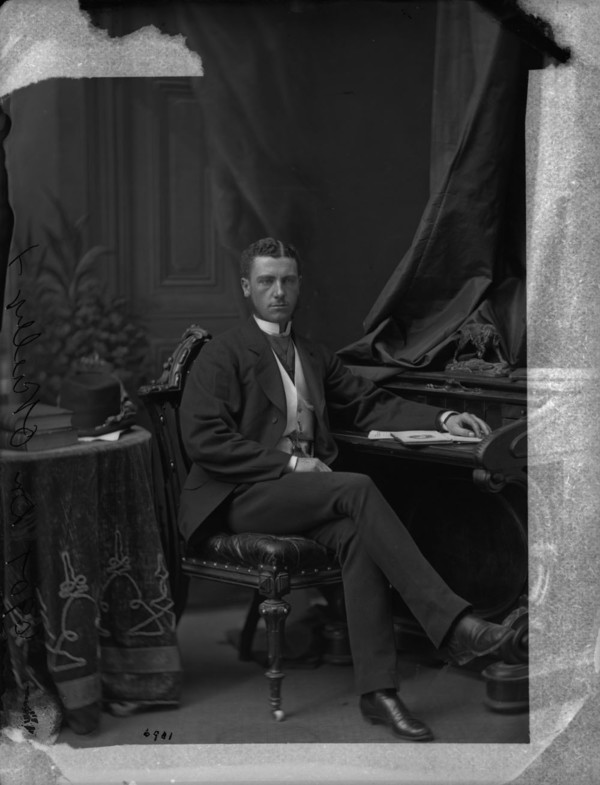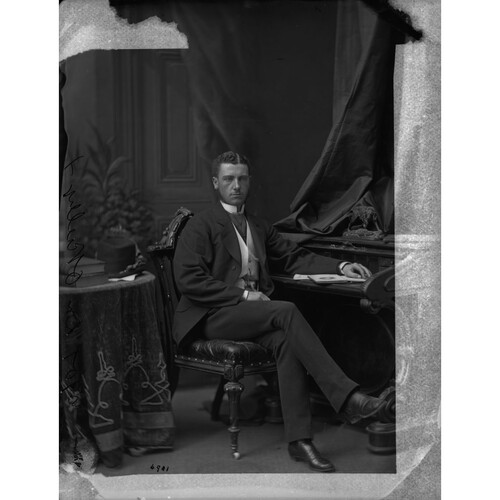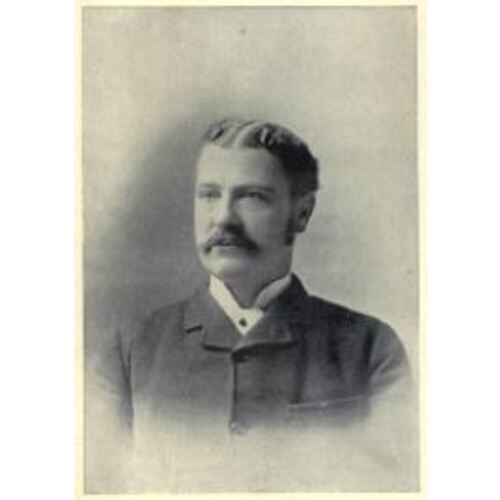O’REILLY, CHARLES, physician, office holder, hospital administrator, and educator; b. 19 June 1846 in Hamilton, Upper Canada, son of Gerald O’Reilly* and Henrietta Waters; m. 10 Oct. 1876, in Dundas, Ont., Sophia Elizabeth Rolph, niece of John Rolph*, and they had a son; d. 3 May 1920 in Toronto.
After acquiring a medical licence in Ireland, Gerald O’Reilly settled permanently in Hamilton, where he built a prosperous practice and established a network for the success in medicine of the next two generations of his familoung Charles O’Reilly attended private schools there and in 1863 entered McGill College in Montreal to study medicine; he graduated in 1867.
Benefiting apparently from the connections of his father, who had died in 1861, O’Reilly returned to Hamilton to become resident physician at the City Hospital at the age of 21. With the establishment of Hamilton’s Board of Health in 1873, he assumed the post of medical officer of health; as well, he served as public vaccinator and police surgeon for the municipality. First in Hamilton and then in Toronto, he supplemented his income by providing basic medical services for an annual fee to members of a benevolent society. He was also active in local and provincial medical bodies.
In late 1875 O’Reilly was recruited by the board of the Toronto General Hospital to be medical superintendent of the financially troubled hospital, then situated near Gerrard and Sackville streets. According to one source, he was chosen because he was an outsider with no “inherent prejudice” regarding the staffs and graduates of the various private schools of medicine in Toronto. His long service as superintendent of TGH, from January 1876 until April 1905, makes him a significant figure in the origins of the modern hospital in Canadian society. His professional survival reflects too his skills in dealing with a board of trustees, municipal and provincial politicians, and medical colleagues. An early leader of the movement to professionalize hospital administration in North America, O’Reilly was in 1902 a founding member and a vice-president of the Ontario Hospital Association, which disappeared within a few years, and later a vice-president of the Hospital Association of the United States.
From the beginning, O’Reilly promoted physicians’ control of TGH. Early in his superintendence a medical advisory board emerged at his urging to represent the interests of the medical staff in dealings with the board of trustees. In turn, the trustees requested the advice of the advisory board on such matters as the number of medical staff, the development of a pharmacopoeia, and the teaching of medical students in clinical theatres rather than in the wards. Following trends elsewhere on the continent, he strengthened the central role of the hospital in the education of nurses and medical students. In the late 1870s he visited schools of nursing in the United States in order to plan such a facility in Toronto. Under O’Reilly’s direction the Toronto General Hospital Training School for Nurses opened in 1881. By the 1890s, under the direction of Mary Agnes Snively*, it had gained an international reputation.
In the field of the medical education of physicians, O’Reilly participated in the integration of the hospital and the medical faculty at the University of Toronto. His major contribution to teaching was in the area of clinical practice. In the 1880s and 1890s he was a clinical examiner for the provincial medical council and the University of Toronto, as well as an examiner for both Trinity Medical School and the St John Ambulance Association, formed in 1895. Throughout his career at TGH O’Reilly supervised hundreds of students who were working towards certification of their clinical experience in order to qualify for licences from the College of Physicians and Surgeons of Ontario. After the re-establishment of the faculty of medicine at the University of Toronto in 1887 [see William Thomas Aikins*], he toured American cities as part of a university delegation exploring the role of the hospital in medical education. His work in medical education was, however, overshadowed by the financial difficulties confronting TGH.
In O’Reilly’s era the hospital was primarily a charitable institution serving the city’s working class. Most of its budget came from private donations and municipal and provincial grants, and the main problem was chronic underfunding. This difficulty forced O’Reilly to adopt a policy of financial austerity and to make himself a “master of economy.” A former student, Dr Herbert Alexander Bruce*, recounted O’Reilly’s dedication to holding down costs by his repair of surgical instruments and insistence that doctors use sleeves during surgery instead of entire gowns.
O’Reilly was able before 1900 to raise additional funds from various benefactors to enlarge the hospital’s facilities. Among the improvements between 1876 and 1891 were the expansion of the main hospital building, the construction on the grounds of the Andrew Mercer Eye and Ear Infirmary and the Pavilion (for “special diseases of Women and Abdominal Surgery”), and the hospital’s amalgamation with the Burnside Lying-In Hospital. As a result, the number of beds rose during this period from 150 to 400, with an increase in annual admissions from 816 to 2,995. In addition, O’Reilly was instrumental in 1881 in the introduction of an ambulance service.
Notwithstanding these advances, TGH under O’Reilly was increasingly unable to keep up with the rising demands of a city swamped by dramatic growth after 1900. O’Reilly was swept aside at the beginning of the massive reforms initiated by Toronto meat-packer Joseph Wesley Flavelle*, who had joined the hospital’s board in 1902 and became chairman in 1904. Flavelle masterminded the construction of a new hospital, which would open in 1913 on College Street at University Avenue. In response to the “tension” arising from the pressure for change, O’Reilly resigned as superintendent near the end of April 1905 and returned to private practice in Toronto. An Anglican, he died in 1920 at his home on St Clair Avenue West and was buried in Mount Pleasant Cemetery.
Charles O’Reilly’s administration represented the first modern stage in the development of TGH as a municipal institution supported by the combined interests of government, business, and the medical profession. His resignation in 1905 signalled the end of the era of the hospital as a charity, and the beginning of its transformation into a centre of increasing medical technology, appealing to and funded and utilized by the middle and upper classes.
AO, RG 22-305, no.40934; RG 80-5-0-62, no.12010; RG 80-8-0-795, no.4499. Evening Telegram (Toronto), 5 May 1920. Hamilton Spectator, 26 April 1905. World (Toronto), 4 May 1920. Michael Bliss, A Canadian millionaire: the life and business times of Sir Joseph Flavelle, bart., 1858–1939 (Toronto, 1978). Canadian album (Cochrane and Hopkins), 1: 45. Canadian men and women of the time (Morgan; 1898 and 1912). William Canniff, The medical profession in Upper Canada, 1783–1850 . . . (Toronto, 1894; repr. 1980). C. K. Clarke, A history of the Toronto General Hospital . . . (Toronto, 1913). W. G. Cosbie, The Toronto General Hospital, 1819–1965: a chronicle (Toronto, 1975). DHB, vol.1. S. E. D. Shortt, “The Canadian hospital in the nineteenth century: an historiographic lament,” JCS, 18 (1983–84), no.4: 3–14. Toronto General Hospital, Annual report, 1891, 1906.
Cite This Article
Paul Adolphus Bator, “O’REILLY, CHARLES,” in Dictionary of Canadian Biography, vol. 14, University of Toronto/Université Laval, 2003–, accessed December 22, 2025, https://www.biographi.ca/en/bio/o_reilly_charles_14E.html.
The citation above shows the format for footnotes and endnotes according to the Chicago manual of style (16th edition). Information to be used in other citation formats:
| Permalink: | https://www.biographi.ca/en/bio/o_reilly_charles_14E.html |
| Author of Article: | Paul Adolphus Bator |
| Title of Article: | O’REILLY, CHARLES |
| Publication Name: | Dictionary of Canadian Biography, vol. 14 |
| Publisher: | University of Toronto/Université Laval |
| Year of publication: | 1998 |
| Year of revision: | 1998 |
| Access Date: | December 22, 2025 |





